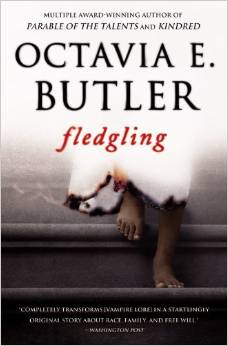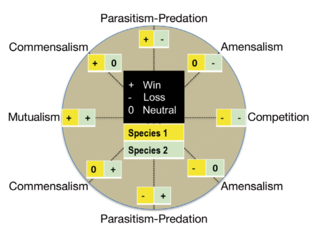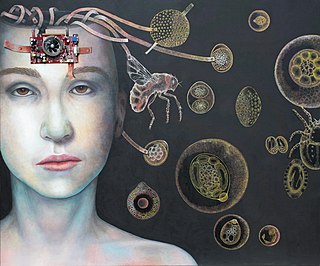Related Research Articles

Symbiosis is any type of a close and long-term biological interaction between two biological organisms of different species, termed symbionts, be it mutualistic, commensalistic, or parasitic. In 1879, Heinrich Anton de Bary defined it as "the living together of unlike organisms". The term is sometimes used in the more restricted sense of a mutually beneficial interaction in which both symbionts contribute to each other's support.

Parasitism is a close relationship between species, where one organism, the parasite, lives on or inside another organism, the host, causing it some harm, and is adapted structurally to this way of life. The entomologist E. O. Wilson has characterised parasites as "predators that eat prey in units of less than one". Parasites include single-celled protozoans such as the agents of malaria, sleeping sickness, and amoebic dysentery; animals such as hookworms, lice, mosquitoes, and vampire bats; fungi such as honey fungus and the agents of ringworm; and plants such as mistletoe, dodder, and the broomrapes.

Mutualism describes the ecological interaction between two or more species where each species has a net benefit. Mutualism is a common type of ecological interaction. Prominent examples include most vascular plants engaged in mutualistic interactions with mycorrhizae, flowering plants being pollinated by animals, vascular plants being dispersed by animals, and corals with zooxanthellae, among many others. Mutualism can be contrasted with interspecific competition, in which each species experiences reduced fitness, and exploitation, or parasitism, in which one species benefits at the expense of the other.

Ectosymbiosis is a form of symbiotic behavior in which a parasite lives on the body surface of the host, including internal surfaces such as the lining of the digestive tube and the ducts of glands. The parasitic species is generally an immobile, or sessile, organism existing off of biotic substrate through mutualism, commensalism, or parasitism. Ectosymbiosis is found throughout a diverse array of environments and in many different species.
Dax is a xenomorphic character in the fictional Star Trek universe. The Dax life form is a symbiont—one that lives inside & bonds to Trill humanoid hosts. The first appearance of a Trill was in the episode "The Host" from the fourth season of Star Trek: The Next Generation; in that early version, the personality of the being was entirely that of Odan, the symbiont within the host, whereas the personalities of the Trills in Star Trek: Deep Space Nine are a blending of the symbiont Dax and its sequential Trill hosts. Two of Dax's hosts, Jadzia Dax and Ezri Dax, appear as major characters in Star Trek: Deep Space Nine. Others are only seen in flashbacks and when taking over others' bodies in the DS9 season 3 episode "Facets". Dax's hosts also appear in spin-offs such as Star Trek: The Human Frontier and The Lives of Dax.

In biology and medicine, a host is a larger organism that harbours a smaller organism; whether a parasitic, a mutualistic, or a commensalist guest (symbiont). The guest is typically provided with nourishment and shelter. Examples include animals playing host to parasitic worms, cells harbouring pathogenic (disease-causing) viruses, a bean plant hosting mutualistic (helpful) nitrogen-fixing bacteria. More specifically in botany, a host plant supplies food resources to micropredators, which have an evolutionarily stable relationship with their hosts similar to ectoparasitism. The host range is the collection of hosts that an organism can use as a partner.

In evolutionary ecology, a parasitoid is an organism that lives in close association with its host at the host's expense, eventually resulting in the death of the host. Parasitoidism is one of six major evolutionary strategies within parasitism, distinguished by the fatal prognosis for the host, which makes the strategy close to predation.
Symbiotic bacteria are bacteria living in symbiosis with another organism or each other. For example, rhizobia living in root nodules of legumes provide nitrogen fixing activity for these plants.

The Body Snatchers is a science fiction novel by American writer Jack Finney, originally serialized in Collier's magazine in November–December 1954 and published in book form the following year.

Fledgling is a science fiction vampire novel by American writer Octavia E. Butler, published in 2005.

Microbial symbiosis in marine animals was not discovered until 1981. In the time following, symbiotic relationships between marine invertebrates and chemoautotrophic bacteria have been found in a variety of ecosystems, ranging from shallow coastal waters to deep-sea hydrothermal vents. Symbiosis is a way for marine organisms to find creative ways to survive in a very dynamic environment. They are different in relation to how dependent the organisms are on each other or how they are associated. It is also considered a selective force behind evolution in some scientific aspects. The symbiotic relationships of organisms has the ability to change behavior, morphology and metabolic pathways. With increased recognition and research, new terminology also arises, such as holobiont, which the relationship between a host and its symbionts as one grouping. Many scientists will look at the hologenome, which is the combined genetic information of the host and its symbionts. These terms are more commonly used to describe microbial symbionts.
Human possession in science fiction is an extension within science-fiction literature and film of the mythology of human possession found in many cultures throughout human history. Typically, possession in science fiction involves extraterrestrial parasitic organisms that can take control of a human host. During the Cold War era in the western world, this was often a metaphor for the threat of communism.

Clay's Ark (1984) is a novel by American science fiction author Octavia E. Butler. The last published of her Patternist series, the novel serves as a prequel that accounts for the arrival of the Clay Ark disease that leads to the evolution of clayarks, the mutants that threaten human survival in the series debut novel, 1976's Patternmaster, and 1978's Survivor, which Butler later disavowed.

Cospeciation is a form of coevolution in which the speciation of one species dictates speciation of another species and is most commonly studied in host-parasite relationships. In the case of a host-parasite relationship, if two hosts of the same species get within close proximity of each other, parasites of the same species from each host are able to move between individuals and mate with the parasites on the other host. However, if a speciation event occurs in the host species, the parasites will no longer be able to "cross over" because the two new host species no longer mate and, if the speciation event is due to a geographic separation, it is very unlikely the two hosts will interact at all with each other. The lack of proximity between the hosts ultimately prevents the populations of parasites from interacting and mating. This can ultimately lead to speciation within the parasite.

Parasites appear frequently in biology-inspired fiction from ancient times onwards, with a flowering in the nineteenth century. These include intentionally disgusting alien monsters in science fiction films, often with analogues in nature. Authors and scriptwriters have, to some extent, exploited parasite biology: lifestyles including parasitoid, behaviour-altering parasite, brood parasite, parasitic castrator, and many forms of vampire are found in books and films. Some fictional parasites, like Count Dracula and Alien's Xenomorphs, have become well known in their own right.

Biology appears in fiction, especially but not only in science fiction, both in the shape of real aspects of the science, used as themes or plot devices, and in the form of fictional elements, whether fictional extensions or applications of biological theory, or through the invention of fictional organisms. Major aspects of biology found in fiction include evolution, disease, genetics, physiology, parasitism and symbiosis (mutualism), ethology, and ecology.
The hypothesis or paradigm of Mutualism Parasitism Continuum postulates that compatible host-symbiont associations can occupy a broad continuum of interactions with different fitness outcomes for each member.
References
- 1 2 3 4 Stableford, Brian M. (10 January 2016). "Parasitism and Symbiosis". The Encyclopedia of Science Fiction. Gollancz. Retrieved 25 July 2018.
- ↑ Sanchez-Taylor, Joy (November 2017). "Fledgling, Symbiosis, and the Nature/Culture Divide". Science Fiction Studies. 44 (3): 486–505. doi:10.5621/sciefictstud.44.3.0486.
- ↑ Brooks, Terry (1999). Star Wars Episode I: The Phantom Menace. Ballantine Books.
- ↑ The Hitchhiker’s Guide to the Galaxy: Fit the First BBC Radio 4 program, broadcast 8 March 1978
